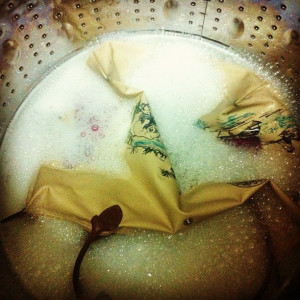
Romanian Embroidery on a Cojoc
I will not comment much on the trademark issues which the choice of ‘Bihor Couture’ could raise, but here are my quick two cents. In the U.S., parody is a defense in a trademark infringement case. If you are interested in this topic, you can read about the recent My Other Bag Second Circuit case here and here.
French trademark law does not have a parody exception, but courts have recognized such a defense, albeit sparingly, when parody was used as a social/political comment (see for instance this case, where the French Supreme Court held in 2008 that article 10 of the European Convention of Human Rights protects the right of non-profit Greenpeace to parody the Areva brand).
Well yes they can, on both sides of the Atlantic, if they are original enough. Embroidery motifs may, however, be in the public domain, or not original enough to be protected by copyright.
 The design was used by Plaintiff on several models, a tote, a coin purse, which Plaintiff started selling in late 2014, early 2015. This season, Balenciaga sold a
The design was used by Plaintiff on several models, a tote, a coin purse, which Plaintiff started selling in late 2014, early 2015. This season, Balenciaga sold a
 Useful articles cannot be protected by copyright, but a pictorial, graphic, or sculptural work incorporated in the useful article can be protected if it is separable from the useful article. However, such design must be capable of being “identified separately from, and [must be] capable of existing independently of the utilitarian aspects of the article,” 17 U.S.C. § 101. The design can be physically separable or “conceptually separable” from its utilitarian aspect. Physical separability occurs if the feature seeking copyright protection can “be physically separated from the article by ordinary means while leaving the utilitarian aspects of the article completely intact,”
Useful articles cannot be protected by copyright, but a pictorial, graphic, or sculptural work incorporated in the useful article can be protected if it is separable from the useful article. However, such design must be capable of being “identified separately from, and [must be] capable of existing independently of the utilitarian aspects of the article,” 17 U.S.C. § 101. The design can be physically separable or “conceptually separable” from its utilitarian aspect. Physical separability occurs if the feature seeking copyright protection can “be physically separated from the article by ordinary means while leaving the utilitarian aspects of the article completely intact,” 





